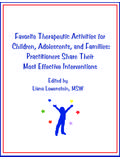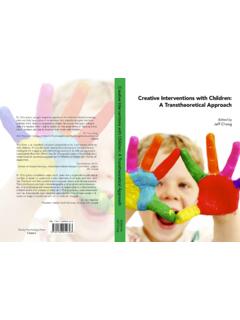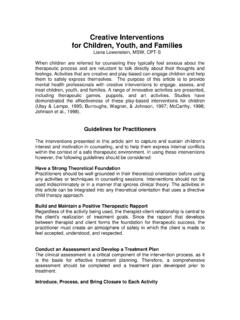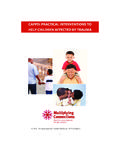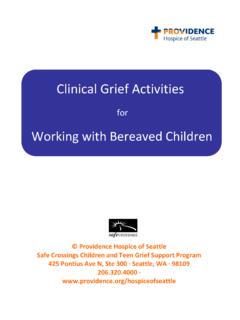Transcription of Resolving Child and Adolescent Traumatic Grief: Creative ...
1 158 Journal of Creativity in Mental Health, 5:158 176, 2010 Copyright Taylor & Francis Group, LLC ISSN: 1540-1383 print/1540-1391 onlineDOI: of Creativity in Mental Health, Vol. 5, No. 2, May 2010: pp. 0 0 Journal of Creativity in Mental HealthResolving Child and Adolescent Traumatic grief : Creative Techniques and InterventionsResolving Child and Adolescent Traumatic GriefM. Edgar-Bailey and V. E. KressMEREDITH EDGAR-BAILEY and VICTORIA E. KRESSY oungstown State University, Youngstown, Ohio, USAThis article presents a review of Creative interventions that can behelpful in facilitating the resolution of Traumatic grief in childrenand adolescents. Traumatic grief is conceptualized as a conditionin which a person loses a close loved one ( , a parent or a sib-ling) in a Traumatic manner, and ensuing trauma-related symp-toms disrupt the normal grieving process.
2 The presented creativeinterventions will be conceptually linked to an evidence-based,cognitive behavioral treatment model that can be used in address-ing Traumatic grief . The Creative interventions presented willinclude the use of writing, storytelling, drawing, commemorating,and ritualizing in relation to Traumatic grief , Traumatic grief , children, treatment, counseling,trauma, creativityIt is estimated that of youth children and adolescents under theage of 18 have experienced the death of a parent (Social Security Adminis-tration, 2000). The leading causes of death for men and women living in theUnited States aged 35 to 54 the most common age range of parents include heart attacks, homicide, suicide, traffic accidents, and otheraccidents (World Health Organization, 2009).
3 The unanticipated and oftentraumatic nature of these leading causes of parental death raises the ques-tion of how children cognitively process the Traumatic aspects of their loss,in addition to navigating the typical grief loss of a parent can impact a Child in a variety of clinically signifi-cant ways, and as such, the Diagnostic and Statistical Manual of MentalAddress correspondence to Victoria E. Kress, Department of Counseling and SpecialEducation, Youngstown State University, Beeghley Hall, Youngstown, OH 44555, : Child and Adolescent Traumatic Grief159 Disorders (DSM) V-Code of Bereavement can be used when the focus ofclinical counseling attention is related to the loss of a loved one (AmericanPsychiatric Association, 2000).
4 In addition, while there are great culturalvariations, some people present for counseling with severe Traumatic griefsymptoms that are similar to a major depressive disorder (MDD). Whenthese depressive symptoms last less than 2 months, they are typically codedand considered typical bereavement unless they affect the person s func-tioning to the point that an MDD diagnosis is warranted. Although the DSMprovides a basic assessment system that can be used to diagnose bereave-ment, a number of more detailed conceptualizations relate to the under-standing of bereavement and complicated bereavement refers to a condition in which bereave-ment is complicated due to the nature of losing a relationship that providedsignificant security and dependency for the bereaved (Cohen & Mannarino,2004).
5 In complicated bereavement, trauma symptoms and separationdistress ensue upon the loss of the relationship (Prigerson, Shear, & Jacobs,1999). Childhood complicated bereavement or complicated grief is aconstruct designed to reflect a clinical syndrome that focuses on separationdistress and yearning as the central features of the condition (Brown et al.,2006). Childhood and Adolescent Traumatic grief (CTG; the focus of thisarticle) is conceptualized as a condition in which a Child or Adolescent losesa close loved one in a Traumatic manner and subsequently develops trauma-related symptoms. These trauma symptoms are conceptualized as disruptingthe typical grieving process (Cohen & Mannarino, 2004).
6 It is important to note that most children and adolescents whoexperience the loss of a loved one do not develop long-term symptoms ofposttraumatic stress disorder (PTSD) or CTG (Brent, Perper, & Moritz, 1993;Brent et al., 1995; Worden & Silverman, 1996). Thus, CTG is not a typical orexpected reaction to a Traumatic loss and should not be treated as such(Cohen & Mannarino, 2004). In other words, it is necessary to provide theappropriate bereavement interventions and not to over-pathologize aclient s experience. Currier, Holland, and Neimeyer (2007) suggest that thetendency for some mental health professionals to pathologize bereavementcan contribute to a decrease in applying established grief interventions andthus delay effective intervention.
7 When a Child experiences CTG, thetrauma-related symptoms associated with the death take precedence overthe Child s experience of the loss (Cohen & Mannarino, 2004). In these situ-ations, the Child can be inhibited sometimes indefinitely toward the endof normal grieving, and thus, Resolving and integrating the loss he or shehas encountered becomes is a paucity of literature related to the use of specific interventionsthat can be helpful in intervening with CTG. This article will present areview of Creative interventions that can be helpful in facilitating the resolutionof Traumatic grief in children and adolescents. Because cognitive-behavioral160M.
8 Edgar-Bailey and V. E. Kresstherapy (CBT) is an evidence-based approach to treating CTG (Cohen &Mannarino, 2004), the presented Creative interventions will be linked theoretically to this model. More specifically, the Creative interventionspresented will include the use of writing, storytelling, drawing, commemo-rating, and ritualizing in relation to treatment of Traumatic grief . Examples ofspecific Creative techniques that counselors may employ in addressing CTGwill be THERAPYMuch of the treatment literature related to addressing CTG focuses on theuse of either play therapy or CBT (Brown, Pearlman, & Goodman, 2004;Cohen & Mannarino, 2004; Salloum & Overstreet, 2008; Webb, 2003).
9 CBT,and more specifically, trauma-focused cognitive behavioral therapy(TFCBT), is widely considered to be the most effective, evidence-basedapproach to treating CTG (Cohen & Mannarino, 2004), and as such, in thisarticle, it will be the theoretical model used to support the use of combination of trauma-focused and grief -focused interventions dem-onstrate the largest reduction of PTSD and depressive symptoms in childrenand adolescents with CTG symptoms (Layne et al., 2001). Trauma-focusedinterventions focus on affective expression skills, stress management skills,creation of the Child s trauma narrative, and cognitive processing (Cohen &Mannarino, 2004).
10 grief -focused interventions focus on talking about death,mourning the loss, addressing ambivalent feelings, preserving positive mem-ories, redefining the relationship, committing to other relationships, andmeaning-making out of the loss (Cohen & Mannarino, 2004). Trauma- andgrief-focused interventions typically both include joint parent- Child is a demonstrated effective treatment for decreasing an array ofchild psychological problems (Cohen & Mannarino, 1996, 1998). Many mal-leable risk factors and protective factors for bereaved youth are related tocognitions and can be increased or decreased as appropriate using CBTinterventions (Haine, Ayers, Sandler, & Wolchik, 2008).
